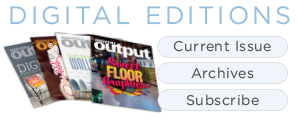By Digital Output Staff
Printed photo applications are still in high demand, despite the constant influx of social media applications that heighten one’s digital presence. Personalized photobooks provide an opportunity to curate a precise collection of printed images out of thousands of digital ones. To do this cost effectively print houses turn to digital.
Book Business
Graphiscan celebrates over 30 years in business. With three locations—one in Alma, QC, Canada and two in Montreal, QC—the company offers a full range of offset, digital, and large format printing with a staff of nearly 100 employees.
Most of the company’s customers are based in Canada, but with the nature of print on demand, the print house is also able to service clients in the U.S., Europe, and the Pacific regions with ease.
Packaging and books are its main products. The company has been producing case bound and perfect bound books, including photobooks, for more than 20 years. Books represent about 60 percent of its business.
One of Graphiscan’s two Montreal locations specializes in digital print production. The digital technology and expertise helps the company serve print on demand markets as well as book making. “We’re able to produce book of one orders very efficiently with great quality,” offers Alex Legue, director of operations, Graphiscan.
Adding digital to the business was inevitable, according to League. When the company began producing photobooks and customers started to request smaller runs down to one, it became apparent that investing in digital was a must.
“Our clients asked for better turnarounds, shorter runs, and all of that with great quality. So the digital transformation of one of our plants was inevitable. We’ve been serving them now for a long time and it’s been fantastic,” admits Legue.
In house, the print shop runs several HP Indigos, a few Canon VarioPrints, and Xerox equipment. Legue refers to its HP Indigos as “workhorses” and admits these printers help Graphiscan stand apart from its competitors. “We’ve been partners with HP for years now, and its equipment is what’s required in terms of productivity and quality needed by our clients today. They run well, they run fast, and their quality is unbeatable for short-run printing.”
Upping Efficiencies
Always looking for smart investments to help the company stay ahead of the curve, Graphiscan recently acquired an HP Indigo 100K Digital Press. The B2 digital solution offers print capabilities at up to 6,000 sheets per hour.
“We’ve been upgrading our equipment as much as we can for years now. Digital printing is always becoming faster and better. The quality keeps improving as well as speed. We need to keep up as our clients also have increasing needs. They deserve the best service and quality, and digital equipment helps us with this,” explains Legue.
Part of the purchase included a Horizon fully automated book finishing line from Standard Finishing Systems, which was installed by its dealer, RM Machinery. The BQ-500 Perfect Binder runs inline with the LBF-500 Book Block Feeder, GF-500 Gauzer Feeder, and HT-1000V Three-Knife Trimmer.
The line allows Graphiscan to produce any type of book—no matter how small the order is—quickly. Even if it’s a small order, and another order is right behind with a different size, thickness, or even style—hardcover to soft cover—there is almost no downtime between the two.
“The flexibility of this line and the capability to improve and increase on what we were already doing well is what made it for us. With the automation we’ve tripled our capacities to be able to serve our clients even faster during the rush seasons of the year, like Christmas time for example,” shares Legue.
Prior to the inline system, Graphiscan ran a Standard Horizon BQ-470 Perfect Trimmer with an offline HT-30 Trimmer in its book binding operation. Despite quality being top notch, the offline system was making it difficult to keep up with and meet customers’ shorter lead times.
“We are able to do about 350 books an hour, but as we began doing shorter runs and more book-of-one jobs, we knew we had to find a solution that gave us more automation and increased throughput without sacrificing quality,” explains Legue.
No doubt, part of the success of a fully automated finishing line is the software driving it. Graphiscan recognized this and pursued the purchase of iCE LiNK, which is Horizon’s cloud-based bindery control system.
Legue encourages the use of iCE LiNK for any business that wants to be data driven. The solution provides real-time insight into machine speeds, production capacities, and volumes running a day, week, or month, which allows Legue and his colleagues to make decisions at a business level.
Another benefit of iCE LiNK is the intuitive maintenance monitoring. “Basically, the system sends you an email when maintenance is needed, preventing unnecessary down time. It makes the life of the supervisor and operator easier, and if you do have an error, it tells you exactly what needs to be done to fix it,” says Legue.
Move Those Orders
To enjoy success in the photobook printing space, it takes the right combination of hardware, software, and skill—something Graphiscan has recognized and acted on. Today the company is able to produce up to 1,100 books per hour thanks to a much more automated workflow. “Faster equipment is one thing, but today we need to improve our automation, avoid down time, and make sure our orders move,” concludes Legue. dps
Jan2025, Digital Output


